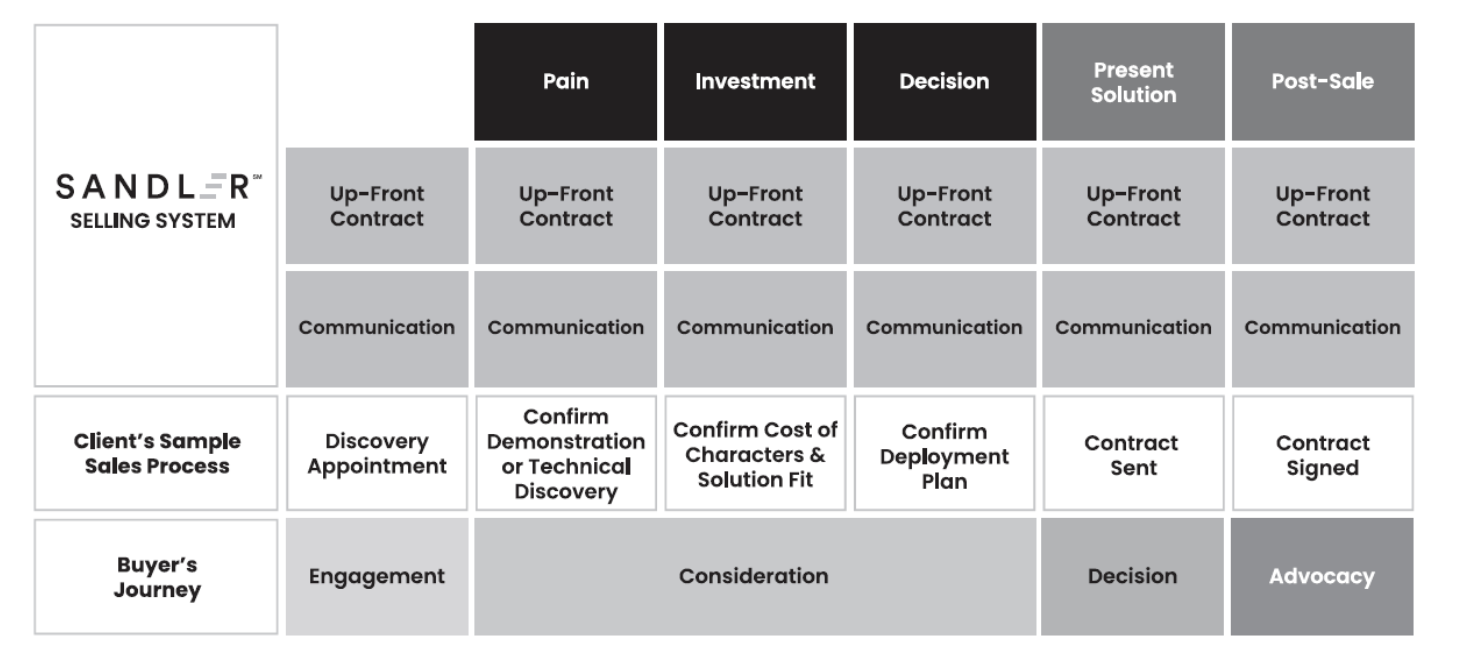The Sandler Selling System: Aligned with the Buyer’s Journey

What process do buyers follow?
We can map out a clear progression, regardless of the person’s title, product, service, or industry. The stages of the buyer’s journey that matter most to salespeople are Engagement, Consideration, Decision, and Advocacy. There is an important stage that precedes Engagement: Awareness. But this article is for sales professionals, who typically don’t have the final say on branding messages that shape Awareness. In this article, I’m focusing on the 4 stages that follow. We must meet buyers wherever they are in this journey and not where we have traditionally started our own process.

ENGAGEMENT: This is where buyers start talking about what they think they need. They may engage with others in the organization, or they may engage with external people, such as their current suppliers or prospective new suppliers. Here, buyers ask themselves:
- Is there a problem?
- Who is it affecting and how?
- If there is, what might be the right response?
- What happens if we do nothing?
What do professional salespeople want to happen during the ENGAGEMENT stage of the buyer’s journey? They want to CONNECT. If there is no connection, they can’t be part of the conversation. So, just like the buyer, salespeople want to engage. They want to hear about the issues people are dealing with internally. They want to get a clear sense of how the buyer sees the world and what their expectations are. If they’ve worked with the person or the organization before, they will want to expand the current relationship to claim a seat at the table and get a sense of what is going on internally and what new problems need solving. If the seller hasn’t worked with the person or the organization before, they will look for ways to initiate contact with the buyer. (That’s called prospecting, of course, and its best practices are constantly changing.) Either way, when that contact is made, sales professionals are going to act on the fact that buyers are looking for a trusting relationship at this stage. They want sales professionals who understand their problem and have successfully dealt with it in the past by setting and executing an agenda that will solve the issue. Accordingly, for setting the conversational agenda, sales professionals use a classic Sandler COMMUNICATION technique known as the UP-FRONT CONTRACT, which sets the stage for the meeting—or for any interaction. In concert with a host of other powerful communication strategies, they create strong bonding and rapport–and make the goals of the discussion clear to both sides. This is engaging. Notice that the up-front contract and the communication strategies that support professional selling inform and support the entire sales process, not just the early stages.
During this part of the buyer journey, sales professionals face these questions:
- What is the best strategy for connecting? (Note: It is likely to involve multiple platforms.)
- With whom should we connect?
- How do we get a seat at the table?
CONSIDERATION: The brainstorming has percolated into a desire for information and insights that support some specific course of action. Three questions come to the forefront of the buyer’s mind during this stage:
- What is the real problem here?
- What are our options for solving it?
- Who could we reach out to for a possible solution?
Notice, however, that no coalition for solving any problem exists yet in the buyer’s world.
What do professional salespeople want to happen during the CONSIDERATION stage of the buyer’s journey? In the second stage of the buyer’s journey, Consideration, sales professionals want to CONFIRM THAT THE POTENTIAL SOLUTION, THE BUDGET, AND THE DECISION-MAKING PROCESS constitute a good fit for both sides. This involves eliminating any ambiguity about the answers to the following questions:
- What pain is the buyer experiencing?
- Whom does that pain affect?
- Can we make it disappear?
- Is the buying organization willing to invest resources to make a solution happen?
- Who will decide whether to implement the solution?
- How will that person or people decide whether to go forward?
- What is the business case for working together?
- How we are different from the competition? What do we offer that they don’t?
Note that if the buyer does not have a real, solvable issue that has an impact on the organization and/or the individual, they are highly unlikely to move forward. And if no resources are available to solve the problem, they can’t move forward.
In Sandler terms, identifying the PAIN, identifying the potential INVESTMENT, and clarifying the DECISION-MAKING PROCESS are the three steps of the qualification process, which is essential. We never want to present before we have qualified the opportunity.
DECISION: Now that the buyer knows, or believes they know, what the problem is and has assembled a list of options for solving that problem, a different set of questions emerges. For instance:
- How much is it going to cost us – in terms of money and other resources – to solve this problem?
- Do we even want to solve this problem? (They may not.)
- How much is it going to cost us – in terms of money and other resources – to solve this problem?
- How are we going to decide between providers?
Ultimately, some kind of capital is invested at this point. That it may be financial resources, or it may be the political capital connecting to a given course of action — including, potentially, the course of taking no action.
What do professional salespeople want to happen during the DECISION stage of the buyer’s journey? Sales professionals want to responsibly, professionally, and ethically FACILITATE all the important discussions that take place internally during the Decision stage of the buyer’s journey, or as many of them as possible.
- How can we facilitate the discussions that support a decision?
Once we assume the Facilitator role, we are in the driver’s seat, which is where we want to be. And here’s the fascinating thing: If in fact we do understand all their issues, and we do have a solution that removes the pain, and we have identified all the resources and mapped out the entire decision-making process, then we should be leading this discussion. Why? Because providing this solution is our area of expertise. Not only that. We should “close” this business even before we PRESENT OUR SOLUTION. The presentation we deliver is, ideally, the fulfillment of all the work that has happened up to this point to create a decision that makes sense for both sides.
Once we get a commitment to do business, we’re not done. At this point, we’re going to begin an important part of our process known as the post-sale, which also shows up in the fourth stage of the buyer’s journey. The post-sale (which we should plan for ahead of time) will take us through the following decision tree.
Did you close the sale?
No:
- Conduct a post-mortem
- Secure future business
Yes:
- Enable implementation
- Prevent loss of sale
- Secure future business
ADVOCACY: Here, based on the experience they’ve had with an external person and/or institution they’ve bought from, the buyer becomes a raving fan and advocates on behalf of the selling party. Basically, they ask:
- Did the provider actually solve our problem?
- If so, do they have any other solutions, or could they help us again somehow?
- Who else should know about this?
The challenge for sales professionals is: How do we get them to that point?
What do professional salespeople want to happen during the ADVOCACY stage of the buyer’s journey? Start by considering that when someone says, “Yes,” that’s just the beginning. To increase the odds that we will deliver the goods and inspire the person who bought from us to become an advocate on our behalf, we will look beyond the immediate question of whether the sale has “closed.” We will focus instead on the question of WHETHER A STRONG RELATIONSHIP HAS OPENED UP.
With that critical priority in mind, we want to ask ourselves the following questions:
- Have we dealt with any issues that came up during the earlier steps of the sales process that might make the buying party want to reconsider some aspect of their decision to work with us?
- How can we make sure that the sales handoff to our delivery team and the buyer’s team internally is impeccable?
- Has all the paperwork been completed properly?
That first one seems counterintuitive to some people. But it’s vitally important. If the buyer is going to second-guess a decision, we gently help them to do so. Although you may not be used to selling this way, you will find, time and time again, that the buyer works out the issue and moves forward with the sale. In the rare instances that there is a problem, you clearly missed something, so you will want to go back and use your communication skills to figure out what it is and address it.
Here is a very basic example: The buyer wanted red in the opening phases of the discussion. We don’t have red in stock. They seem to be okay with light blue, but even though we’re “past it,” we don’t want to hide that issue. We’re going to bring it up ourselves right after we get the initial commitment to work together. That’s because we want to make sure that things that have been accepted only grudgingly aren’t going to come back to bite us in the rear end. In addition, we’re going to ask, explicitly, what might arise that could cause the buyer to change their mind about working with us.
This idea scares a lot of salespeople, but the fear they feel is what marks the transition from amateur to professional. Think about it. Everybody who sells for a living has had a run-in, at one point or another, with buyer’s remorse. This POST-SALE step is all about taking buyer’s remorse right off the table. It’s about surfacing the issues while you are still face-to-face and can do something about them. It’s about laying the groundwork for the kind of long-term relationship that makes the buyer glad they decided to buy from you–so glad, in fact, that they recommend you to others. That is advocacy.
Here is the whole system, aligned with the buyer’s journey:

For help with aligning your team’s sales process with your ideal customer’s buying journey, contact us. To learn about the 52 Sandler selling rules that support both you and the buyer, see my book How to Sell to the Modern Buyer.








